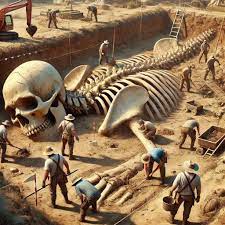Archaeologists Discover Alien-Like Skeleton in Desert, Redefining Human Origins!
The report of archaeologists discovering an “alien-like” skeleton in a desert, with the claim that it redefines human origins, is a prime example of a recurring theme in sensationalized news. These stories, which often go viral, typically blend real archaeological concepts with fantastical, unverified claims. The most famous case of this phenomenon involves the so-called “Atacama Alien,” a tiny, six-inch skeleton discovered in Chile’s Atacama Desert in 2003. Its bizarre, elongated skull and unusual features led many to speculate that it was an alien, a mutated human, or a new species.

However, scientific analysis ultimately debunked these extraordinary claims. Genetic testing performed by Stanford University scientists revealed that the skeleton was, in fact, human. The individual was a female fetus or infant who likely died in the mid-to-late 20th century. The “alien-like” features were attributed to a combination of severe genetic mutations and deformities, possibly including a condition like microcephaly, which caused the malformed and elongated skull, and dwarfism, which accounted for its small size. The researchers concluded that the skeleton, despite its strange appearance, offered no evidence of extraterrestrial life.

The widespread fascination with such claims highlights a deep-seated human desire to believe in the existence of alien life and to uncover a “secret” history of humanity. While legitimate archaeological discoveries do sometimes challenge and revise our understanding of the past, they do so through rigorous, peer-reviewed scientific methods. Claims of “alien-like” skeletons and their ability to “redefine human origins” are almost invariably proven to be either hoaxes, misinterpretations, or the unfortunate remains of a human with congenital abnormalities. The true story of such discoveries, while less dramatic, often provides a poignant and scientifically valuable glimpse into human genetics and disease.
